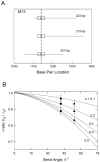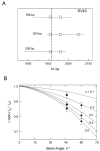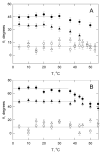Effect of magnesium ions and temperature on the sequence-dependent curvature of DNA restriction fragments
- PMID: 21406776
- PMCID: PMC3151479
- DOI: 10.1088/0953-8984/22/49/494110
Effect of magnesium ions and temperature on the sequence-dependent curvature of DNA restriction fragments
Abstract
Transient electric birefringence has been used to quantify the curvature of two DNA restriction fragments, a 199-base-pair fragment taken from the origin of replication of the M13 bacteriophage and a 207-base-pair fragment taken from the VP1 gene in the SV40 minichromosome. Stable curvature in the SV40 and M13 restriction fragments is due to a series of closely spaced A tracts, runs of 4-6 contiguous adenine residues located within 40 or 60 base pair 'curvature modules' near the center of each fragment. The M13 and SV40 restriction fragments exhibit bends of ∼ 45° in solutions containing monovalent cations and ∼ 60° in solutions containing Mg(2 +) ions. The curvature is not localized at a single site but is distributed over the various A tracts in the curvature modules. Thermal denaturation studies indicate that the curvature in the M13 and SV40 restriction fragments remains constant up to 30 °C in solutions containing monovalent cations, and up to 40 °C in solutions containing Mg(2 +) ions, before beginning to decrease slowly with increasing temperature. Hence, stable curvature in these DNA restriction fragments exists at the biologically important temperature of 37 °C.
Figures






Similar articles
-
Monovalent cation binding by curved DNA molecules containing variable numbers of a-tracts.Biophys J. 2008 Mar 1;94(5):1719-25. doi: 10.1529/biophysj.107.121236. Epub 2007 Nov 9. Biophys J. 2008. PMID: 17993492 Free PMC article.
-
Intrinsic curvature in the VP1 gene of SV40: comparison of solution and gel results.Biophys J. 2005 Feb;88(2):1191-206. doi: 10.1529/biophysj.104.039834. Epub 2004 Nov 19. Biophys J. 2005. PMID: 15556988 Free PMC article.
-
Curved DNA molecules migrate anomalously slowly in free solution.Nucleic Acids Res. 2005 Aug 5;33(14):4425-32. doi: 10.1093/nar/gki748. Print 2005. Nucleic Acids Res. 2005. PMID: 16085753 Free PMC article.
-
Analysis of DNA bending by transient electric birefringence.Biopolymers. 2003 Oct;70(2):270-88. doi: 10.1002/bip.10458. Biopolymers. 2003. PMID: 14517915
-
Molecular dynamics simulations of DNA curvature and flexibility: helix phasing and premelting.Biopolymers. 2004 Feb 15;73(3):380-403. doi: 10.1002/bip.20019. Biopolymers. 2004. PMID: 14755574 Review.
Cited by
-
Probing the elastic limit of DNA bending.Nucleic Acids Res. 2014;42(16):10786-94. doi: 10.1093/nar/gku735. Epub 2014 Aug 13. Nucleic Acids Res. 2014. PMID: 25122748 Free PMC article.
References
-
- Hagerman P. Annu. Rev. Biophys. Biophys. Chem. 1988;17:265–286. - PubMed
-
- Lu YJ, Weers B, Stellwagen NC. Biopolymers. 2002;61:261–275. - PubMed
-
- Olson WK, Zhurkin VB. Biological Structure and Dynamics. Adenine Press; Schenectady, NY: 1996. pp. 341–370.
-
- Hud NV, Plavec J. Biopolymers. 2003;69:144–159. - PubMed
-
- Haran TE, Mohanty U. Q. Rev. Biophys. 2009;42:41–81. - PubMed
Grants and funding
LinkOut - more resources
Full Text Sources
